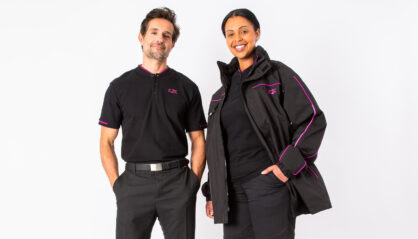Build Positive Brand Awareness with Plastic-Free Workwear

Sustainable workwear is entering the business space as more and more employers are seeking ethical choices. Eco-friendly uniforms not only reduce the use of plastic but also promote fair working conditions and a sustainable supply chain. They are more durable and have an extended lifespan that only adds to the design and comfort of the garment.
Today, we discuss why plastic is bad for the environment and how you can reduce your ecological footprint through sustainable uniforms. In return, you’ll gain more positive brand awareness, increase your employee satisfaction rate, and cut costs in the long run.
How is plastic harmful?
Plastics such as polyethylene, polystyrene, and nylon are present in most of our garments. Throughout the lifetime of a garment, it sheds tiny plastic particles known as plastic microfibres, especially when it is washed.
Unfortunately, these plastic are extremely dangerous to both the planet and us, because they aren’t biodegradable and can’t be recycled. They can easily enter the environment and harm marine life and our entire food system.
According to Friends of the Earth, washing clothes in the UK generates around 4,000 tonnes of plastic microfibre every year. 1,600 tonnes of those can be ending up in our bodies of water. To put this in perspective, up to 17 million microplastic fibres can be shed during one washing load of clothes.
Reducing the use of plastic through sustainable workwear is one way to make a positive environmental impact. There are two ways you can do that.
How much plastic goes into uniform production?
The first thing you need to address if you want to reduce plastic in workwear is the production process. One way your company can showcase environmental awareness is by opting for uniforms made from sustainable fabrics. Organic linen, cotton, and wool, for example, are made from 100% natural materials, and they are extremely durable, recyclable, and biodegradable.
One linen shirt, for example, uses only 6.4 litres of water across its lifecycle. Moreover, it’s a no-waste production method, as every bit of the flax plant is utilised. We are all familiar with the amazing benefits of linseed oil, for example.
Recycled plastic bottles and recycled yarn are a great alternative to synthetics, and they make great garments too. Through using such materials you’re also eliminating some of the plastic that’s harming the environment.
Let’s calculate how many plastic bottles go into the production of a standard dress, which is made from Recycled Polyester Taffeta 300T? It is established that a full 150-metre-long roll contains 471.65 2-litre recycled plastic soda bottles. That means that one metre of fabric contains 3.14 2-litre soda bottles. If a standard collar-to-ankle dress uses 4 metres of fabric, it will require 12.56 2-litre recycled plastic soda bottles to be made.
Wrapped in plastic
Plastic is not only used in clothing manufacturing, but it also makes its way to packaging. According to the Pitney Bowes Shipping Index, over 130 billion packages are shipped yearly across 13 major global markets, and most of them are encased in plastic packaging. That figure is estimated to double by 2060.
The UK is working towards reducing plastic packaging. From April 2022, a plastic packaging tax is being introduced, which applies to plastic packaging that isn’t made from at least 30% recycled plastic. This will promote the production of sustainable packaging, which is an essential feature to look out for when sourcing workwear for your business. Ann Dowdeswell, Sales and Marketing Director at the workwear supplier Jermyn Street Design, commented:
“Today, we are all well aware of the negative impact of plastic packaging, and we are all committed to eliminating single-use plastic as much as we can. At Jermyn Street Design, we use recycled, recyclable, or compostable packaging when shipping our products. In order to combat the higher distribution costs associated with eco-friendly packaging, we have streamlined our deliveries. We have even created a custom method of packaging shirts that eliminates all the plastic clips and collar stays that are traditionally used.”
Making a positive environmental impact is a great mindset to implement into your company. You can do this not only through reducing the use of plastic but also by supporting ethical production and minimising labour exploitation. Find out more about our ethics & sustainability initiatives HERE.
That’s what eco-friendly uniforms stand for. They’re the future of business, and the future starts today!
Sources
https://get-green-now.com/how-do-microplastics-affect-the-environment/
https://www.ethicalconsumer.org/fashion-clothing/plastic-pollution-clothing
https://goodonyou.eco/how-sustainable-is-linen/
https://www.vivifytextiles.com/blogs/news/how-many-plastic-bottles-can-you-save
https://stitchingmall.com/how-to-know-fabric-requirement-for-your-dress





